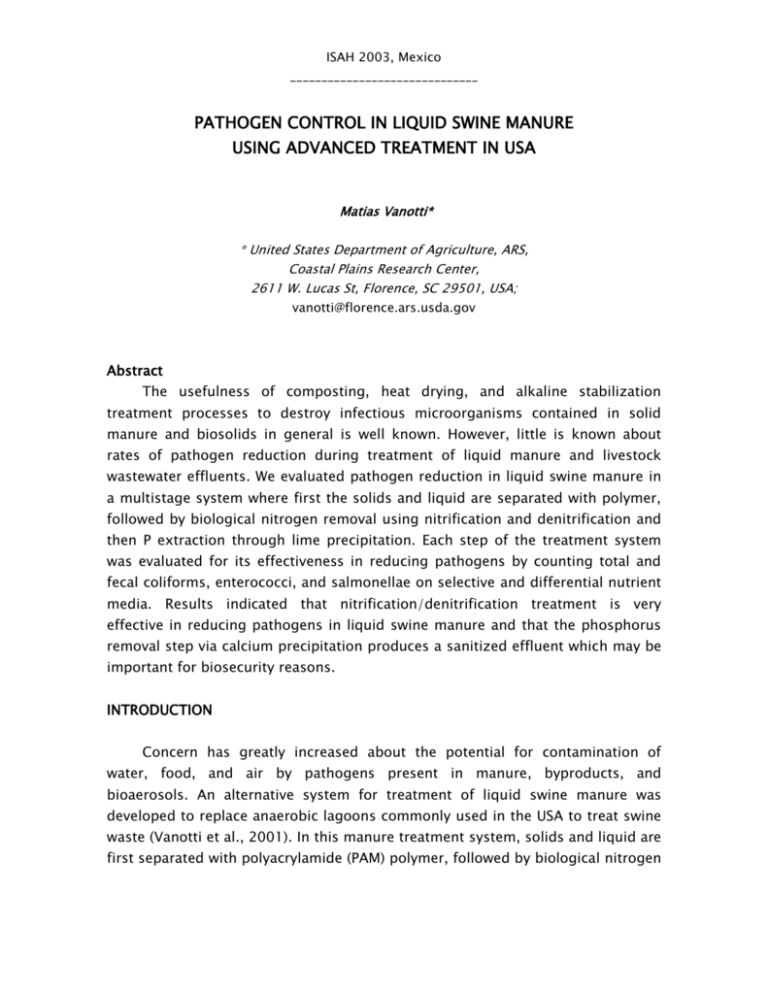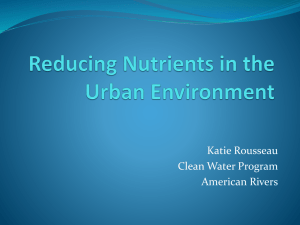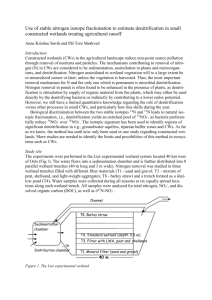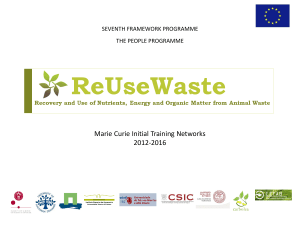pathogen control in liquid swine manure using advanced treatment
advertisement

ISAH 2003, Mexico ______________________________ PATHOGEN CONTROL IN LIQUID SWINE MANURE USING ADVANCED TREATMENT IN USA Matias Vanotti* * United States Department of Agriculture, ARS, Coastal Plains Research Center, 2611 W. Lucas St, Florence, SC 29501, USA; vanotti@florence.ars.usda.gov Abstract The usefulness of composting, heat drying, and alkaline stabilization treatment processes to destroy infectious microorganisms contained in solid manure and biosolids in general is well known. However, little is known about rates of pathogen reduction during treatment of liquid manure and livestock wastewater effluents. We evaluated pathogen reduction in liquid swine manure in a multistage system where first the solids and liquid are separated with polymer, followed by biological nitrogen removal using nitrification and denitrification and then P extraction through lime precipitation. Each step of the treatment system was evaluated for its effectiveness in reducing pathogens by counting total and fecal coliforms, enterococci, and salmonellae on selective and differential nutrient media. Results indicated that nitrification/denitrification treatment is very effective in reducing pathogens in liquid swine manure and that the phosphorus removal step via calcium precipitation produces a sanitized effluent which may be important for biosecurity reasons. INTRODUCTION Concern has greatly increased about the potential for contamination of water, food, and air by pathogens present in manure, byproducts, and bioaerosols. An alternative system for treatment of liquid swine manure was developed to replace anaerobic lagoons commonly used in the USA to treat swine waste (Vanotti et al., 2001). In this manure treatment system, solids and liquid are first separated with polyacrylamide (PAM) polymer, followed by biological nitrogen ISAH 2003, Mexico ______________________________ (N) removal using nitrification and denitrification and then by phosphorus (P) extraction using a lime precipitation process. The system was successfully tested at the Swine Unit at NC State University Lake Wheeler Field Rd. Laboratory (Vanotti et al., 2003). We also evaluated how pathogens were reduced by each of the process units comprising the total system (Vanotti et al., 2002a). Currently there is a government-industry framework in North Carolina for the conversion of anaerobic swine waste lagoons and spray-fields to alternative technologies. In July 2000, the Attorney General of North Carolina reached an agreement with Smithfield Foods, Inc. and its subsidiaries, the largest hog producing companies in the world, to develop and demonstrate Environmental Superior Technologies (Williams, 2001). Once new technologies are identified, companies will convert their facilities and phase out the current lagoons and sprayfield. In October 2000, the Attorney General reached a similar agreement with Premium Standard Farms, the second largest pork producer in the country. Taken together, Smithfield and Premium Standard represent over 75% of the hog farms in North Carolina. The Agreement defines AEnvironmentally Superior Technologies@ as any technology, or combination of technology that (1) is permittable by the appropriate governmental authority; (2) is determined to be technically, operationally, and economically feasible and (3) meets the following environmental performance standards: 1. Eliminate the discharge of animal waste to surface waters and groundwater through direct discharge, seepage, or runoff; 2. Substantially eliminate atmospheric emissions of ammonia; 3. Substantially eliminate the emission of odor that is detectable beyond the boundaries of farm; 4. Substantially eliminate the release of disease-transmitting vectors and airborne pathogens; and 5. Substantially eliminate nutrient and heavy metal contamination of soil and groundwater. A full-scale treatment system was constructed under this program for full-scale demonstration and environmental performance verification at a 4,360-pig farm in North Carolina=s Duplin County using the technologies outlined in this paper (liquid-solid separation, nitrification/denitrification, and soluble P removal). The system was constructed by Super Soil Systems USA of Clinton, NC, and will be evaluated through 2003 for verification of Environmental Superior Technology. MATERIALS AND METHODS A prototype of a system without lagoon was evaluated at the Swine Unit of ISAH 2003, Mexico ______________________________ the NCSU Lake Wheeler Rd. Laboratory in Raleigh, North Carolina (Vanotti et al., 2002b and 2003). The total system is shown in fig. 1. It included solid-liquid separation, biological N removal, and P treatment. Solid-liquid Separation Flushed manure from finishing houses in the facility was collected in a 15m3 (4000-gal) homogenization tank. For solid-liquid separation, we used an in- line PAM injector and mixer to flocculate the solids in the flush and two sand filter beds (20 x 16 ft) for dewatering. Both the in-line PAM injector and filter beds were components of the Deskins1 process (F.D. Deskins Company, Inc., Alexandria, Ind.) used for municipal sludge dewatering. Flushed manure was homogenized and pumped to the polymer injection unit at 130 gal/min and then poured on the sand filter bed. The polymer used was a cationic emulsion (c1596, Cytec Industries, Inc., West Paterson, N.J.). The beds received 30-cm depth of flocculated manure during each pour. Detailed information and performance evaluation on this unit was provided by Vanotti et al. (2002b). The sand filtrate was stored in a 4000 gal tank and fed into the denitrification tank. 1 Mention of trademark, proprietary product, or vendor does not constitute a guarantee or warranty of the product by the U.S. Dept. of Agriculture and does not imply its approval to the exclusion of other products or vendors that also may be suitable. ISAH 2003, Mexico ______________________________ CONFINED LIVESTOCK DENITRIFICATION NITRIFICATION TANK BIOREACTOR RAW MANURE CLARIFIER P RECYCLE FLOCCULANT PHOSPHORUS SEPARATION REACTOR TREATED EFFLUENT SOLID SEPARATION UNIT BLOWER B PHOSPHATE PRECIPITATE SOLIDS & SLUDGE EXCESS SLUDGE RETURN SLUDGE Figure 1. Schematic drawing of the pilot waste treatment system without lagoon (Vanotti et al., 2001). Biological Nitrogen Removal A Biogreen process that uses nitrifying pellets in an aerated tank and denitrifying sludge in anoxic tanks was used to treat the effluent after solids separation with PAM. The pilot unit was designed to treat 1 m3/day of liquid at 10oC water temperature. It contained a 1.3-m3 anoxic denitrification tank (DN1) with ~ 3 g/L MLVSS to remove soluble carbon and NO3-N, a 0.55-m3 nitrification tank containing 100 L of polyethylene glycol (PEG) pellets for conversion of NH4+ to NO3-, and a 0.63-m3 clarification tank for settling of suspended solids. The unit also included a second 0.63-m3 tank with methanol injection for postdenitrification when needed and a small 20-L oxic tank to enhance settleability. The nitrifying pellets were provided by the Hitachi Plant Construction & Engineering Co. of Tokyo, Japan. The pellets were already acclimated to swine wastewater in a 60-day procedure where nitrification activity increased from 0 to an optimum of 790 g N/100-L pellets/day. Nitrified liquid was recirculated (RN) ISAH 2003, Mexico ______________________________ to the denitrification tank (DN1) at a rate of 5 m3/day and settled sludge was recycled (RS) at 0.5 m3/day. The effluent from this unit was subsequently treated in the phosphorus reactor. Phosphorus Removal The phosphorus reactor was placed after the clarifier (fig. 1) to precipitate and separate the soluble P before discharge. It consisted of a 379-L (100-gallon) plastic tank with conical bottom made of XLPE resin and a mixer. A smaller 114-L (30-gallon) tank and mixer was used to prepare the lime milk (2% hydrated lime mixture in water). A peristaltic pump connected to a pH controller was used to transfer the lime milk into the P-reactor. A magnetic flow meter measured the total amount of chemical added in each treatment. The chemical was a highpurity, commercial hydrated lime powder containing 98.5% Ca(OH) 2 and with a mean particle size of 3.5 micron (Codex Hydrated Lime, Mississippi Lime Company, Alton, Ill.). Hydrated lime was injected into the stirred reactor containing wastewater effluent from biological N removal module. A pH controller stopped injection when the pH of the mixed liquid reached a set point of 10.5. Once the desired treatment pH was reached, the mixer was turned off and the liquid was allowed to settle for about 30 min. After this settling period, duplicate liquid samples were collected from the supernatant for water quality determinations. The precipitated solids were removed by gravity from the bottom of the reactor and collected in plastic containers. A total of 5 runs of the system were conducted over a 3.5-month period. Microbiological Analyses Each step of the treatment system was evaluated for its effectiveness in reducing pathogens, by counting total and fecal coliforms, enterococci, and salmonellae on selective and differential nutrient media using the standard protocols for pathogens and indicator microbes for the examination of compost and water. Fecal coliforms and presumptive E.coli were enumerated by using MacConkey’s agar plates containing 100 g/mL of MUG. Incubation of these plates at 44.5C selected for fecal coliforms and a fluorescent blue halo around a colony when exposed to UV light at 365nm was indicative of E.coli. Total coliforms were enumerated on MacConkey’s agar incubated at 37C overnight. ISAH 2003, Mexico ______________________________ Enterococci were enumerated on Modified Enterococcus agar incubated at 37C overnight. Salmonellae were enumerated by spiral plating on XLT4 agar and incubating the plates at 37C. A colony lift immunoassay specific for Salmonella serotypes was performed on presumptive Salmonella colonies for confirmation of Salmonella. Wastewater Sampling Samples were collected five times approximately 3 weeks apart during a three month period (July-Oct.). The samples were obtained from the following four points in the system: 1. the homogenization tank receiving and mixing liquid manure from the barns, 2. the effluent of the sand filter after liquid-solids separation (postpolymer), 3. the effluent after the nitrification/denitrification step (post-N removal), and 4. the effluent after the phosphorus extraction step (post-P removal). One set of duplicate samples was overnight shipped with coldpacks to the ARS Animal Waste Pathogens Laboratory in Beltsville, Maryland for microbial analysis. Another set of duplicate samples was transported on ice to the ARS Coastal Plains Research Center in Florence, South Carolina for water quality analyses. Before microbial analysis, the pH of the post-P removal samples was brought down from 10.3 to 8.0 using 6N H2SO4. ISAH 2003, Mexico ______________________________ RESULTS AND DISCUSSION Solids and Nutrient Treatment Data in table 1 show the changes in wastewater characteristics after going through solid-liquid separation and nutrient treatment. Solid-liquid separation removed 98% of the total suspended solids (TSS) and volatile suspended solids (VSS), 93% of the BOD, and > 80% of the organic N and P. By capturing the suspended particles, most of the volatile and oxygen-demanding organic compounds are removed from the liquid stream which facilitates nitrogen treatment. Instead of being used to break down organic compounds, the oxygen in the subsequent aeration treatment is used efficiently to convert ammonia to nitrate. Soluble ammonia was completely removed during N treatment 98.5% of the total phosphorus (TP) was removed from the liquid stream after P treatment. After the P removal step, the effluent is virtually free from nutrients and its final acceptability for discharge is enormously improved. Table 1. Removal of nutrient and pollutant indicators from flushed swine manure using advanced treatment (Vanotti et al., 2003). Constituent Raw Manure After Solid- After Biological After P Liquid N Treatment Treatment Separation Removal Efficiency of System (%) TS (mg/L) 12456 (1311) 1902 (104) 1633 (133) 1041 91.6 TSS (mg/L) 10591 (1283) 190 (20) 219 (117) (193) 99.2 VSS (mg/L) 8563 (1037) 145 (15) 168 (86) 89 (7) 99.5 BOD5 (mg/L) 2932 (1178) 217 (46) 56 (14) 41 (11) 99.9 pH 7.01 (0.06) 7.29 (0.03) 7.62 (0.06) 4 (1) -- TKN (mg/L) 688 (49) 232 (13) 11 (5) 10.3 99.7 NH4-N (mg/L) 190 (6) 173 (9) 0 (0) (0.07) 100.0 TP (mg/L) 480 (76) 112 (25) 75 (9) 2 (2) 98.5 PO4-P (mg/L) 33 (2) 38 (4) 54 (3) 0 (0) 97.0 7 (2) 1 (0) ISAH 2003, Mexico ______________________________ Pathogen Treatment Before treatment, concentrations of total and fecal coliforms were 1.10 x 107colony forming units (cfu)/mL and 1.28 x 106 cfu/mL, respectively. Enterococci concentration was 9.52 x 105 cfu/mL and salmonella concentration was 2.3 x 104 cfu/mL (Table 2). Results showed a consistent trend in reduction of salmonellae, total and fecal coliforms, and enterococci as a result of each step in the treatment system. In general, the lowest concentrations of salmonellae and pathogen indicators occurred after nitrification/ denitrification and phosphorus removal steps. Solids-liquid separation with cationic polymer reduced 68% to 83% of the pathogens. Biological N removal conditions destroyed most of the microbes in the liquid with total reductions of 5 logs (99.997%) for total coliforms, 4 logs for fecal coliforms and enterococci, and 2 logs for salmonellae. The N removal process recycles the liquid several times between oxic and anoxic tanks and also promote use of endogenous carbon in denitrification. Our data suggest that these conditions are extremely effective for pathogen destruction. Salmonellae and pathogen indicators were eliminated with the phosphorus treatment in the sequence due to elevated pH (10.3) used to precipitate phosphorus; there were no colonies to count at the upper threshold limit value of < 3 x 101 cfu/mL. Our results indicate that nitrification/ denitrification treatment is very effective in reducing pathogens in liquid swine manure and that the phosphorus removal step via calcium precipitation produces a sanitized effluent which may be important for biosecurity reasons. Such is the case with controlling the introduction and spread of Foot and Mouth Disease virus as an aerosol during liquid manure spreading since the virus is particularly susceptible to pH above 9. Table 2. Microbiological analyses of effluents at each step in the treatment system (Vanotti et al., 2002).a Treatment Point Total Fecal Coliforms Coliforms Enterococci Salmonellaeb (cfu/mL) (cfu/mL) (cfu/mL) (cfu/mL) 107 1.28 x 106 Confirmed 9.52 x 105 Homogenization Tank 1.10 x 2.32 x 104 Post-Polymer 2.30 x 106 4.26 x 105 1.59 x 105 7.21 x 103 Post-Nitrification/ 3.05 x 102 6.80 x 101 4.10 x 101 3.10 x 102 ISAH 2003, Mexico ______________________________ Denitrification Post-Phosphorus Removal a <3.5 x 101 <1.8 x 101 <2.1 x 101 <2.1 x 101 Values are mean of colony forming units (cfu) per mL for duplicate samples for five runs of the system; < indicates there were no colonies to count, thus only the upper threshold limit value can be calculated. b Presumptively positive salmonellae were confirmed by serological test. REFERENCES 1. Vanotti, M.B., A.A. Szogi and P.G. Hunt. 2001. Wastewater treatment system. Patent Application Serial No. 09/903,620. U.S. Patent & Trademark Office, Washington, DC, USA. 2. Vanotti, M.B., P.D. Millner, P.G. Hunt, and A.Q. Ellison. 2002a. Destruction of pathogens in liquid swine manure by biological nitrogen removal and phosphorus treatment. Proc. 10th Conf. of FAO RAMIRAN. May 14-18, Strbske Pleso, Slovak Republic. 3. Vanotti, M.B., A.Q. Ellison, J.M. Rice, P.G. Hunt, F.J. Humenik, and C.A. Baird. 2002b. Solids-liquid separation of swine manure with polymer treatment and sand filtration. ASAE paper #024158. 2002 ASA Annual Int. Meeting, Chicago, Ill. 4. Vanotti, M.B., P.G. Hunt, A.A. Szogi, and A.Q. Ellison. 2003. Extraction of soluble phosphorus in a swine treatment system without lagoon. (Ed.) Robert Burns. In the Animal, Agricultural and Food Processing Wastes, Proc. of the Ninth Int. Symposium (ISAAFPW 2003), Oct. 11-14, 2003. ASAE/CIGR, Raleigh, NC. 5. Williams, C.M. 2001. Smithfield and Premium Standard Farms program implementation. p. 18-21. Proc. Int.Symp. Addressing Animal Production and Env. Issues. NCSU, Raleigh, NC.








